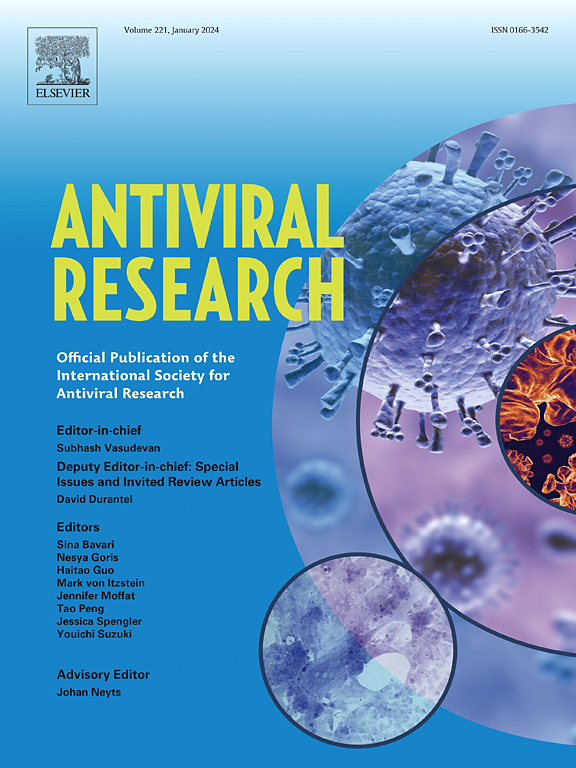Assessing human liver spheroids as a model for antiviral drug evaluation against BSL-3 haemorrhagic fever viruses
IF 4
2区 医学
Q1 PHARMACOLOGY & PHARMACY
引用次数: 0
Abstract
Haemorrhagic fever viruses (HFVs) cause highly lethal syndromes with limited therapeutic options. Increasingly, 3D cell culture models are becoming an important tool in the field of virology. Since the liver is an important target for many HFVs, we evaluated a ready-to-use 96-well liver spheroid model composed of human primary cells for antiviral assessment. We worked with four biosafety level 3 (BSL-3) HFVs in this study: two orthoflaviviruses, Alkhumra haemorrhagic fever virus (AHFV) and yellow fever virus (YFV), and two viruses belonging to Hareavirales order, Pirital virus (PIRV), a surrogate for new-world BSL-4 mammarenaviruses, and Rift Valley fever virus (RVFV). We found that RVFV and PIRV were able to replicate in this model, whereas the orthoflaviviruses were not. A high viral dose was required for robust replication, and infectivity of RVFV in spheroids was low. We successfully demonstrated the antiviral activity of known broad-spectrum antiviral compounds—favipiravir, nitazoxanide, ribavirin, and galidesivir—despite some variability. However, except for ribavirin, higher doses were required in spheroids to detect antiviral effect compared to the 2D cell culture model. Overall, we conclude that human liver spheroids cannot replace traditional models for the selection of antiviral compounds but provide valuable additional complementary information. More broadly, this model could be useful to study viral pathogenicity and host-pathogen interactions.
评估人类肝脏球体作为抗BSL-3出血热病毒抗病毒药物评估的模型。
出血热病毒(HFVs)引起高致命性综合征,治疗选择有限。三维细胞培养模型正日益成为病毒学领域的重要工具。由于肝脏是许多hfv的重要靶点,我们评估了由人原代细胞组成的96孔肝球体模型用于抗病毒评估。在这项研究中,我们使用了四种生物安全级别为3 (BSL-3)的hfv:两种正黄病毒,阿尔库姆拉出血热病毒(AHFV)和黄热病病毒(YFV),以及两种属于Hareavirales目的病毒,PIRV(一种新世界BSL-4乳头状病毒的替代品)和裂谷热病毒(RVFV)。我们发现RVFV和PIRV能够在这个模型中复制,而正黄病毒则不能。需要高的病毒剂量才能实现强大的复制,而裂谷热病毒在球体中的传染性很低。我们成功地证明了已知的广谱抗病毒化合物——favipiravir、nitazoxanide、ribaavirin和galidesvir的抗病毒活性,尽管存在一些差异。然而,除了利巴韦林,与2D细胞培养模型相比,在球体中检测抗病毒效果需要更高的剂量。总之,我们得出结论,人类肝脏球体不能取代传统的抗病毒化合物选择模型,但提供了有价值的额外补充信息。更广泛地说,该模型可用于研究病毒致病性和宿主-病原体相互作用。
本文章由计算机程序翻译,如有差异,请以英文原文为准。
求助全文
约1分钟内获得全文
求助全文
来源期刊

Antiviral research
医学-病毒学
CiteScore
17.10
自引率
3.90%
发文量
157
审稿时长
34 days
期刊介绍:
Antiviral Research is a journal that focuses on various aspects of controlling viral infections in both humans and animals. It is a platform for publishing research reports, short communications, review articles, and commentaries. The journal covers a wide range of topics including antiviral drugs, antibodies, and host-response modifiers. These topics encompass their synthesis, in vitro and in vivo testing, as well as mechanisms of action. Additionally, the journal also publishes studies on the development of new or improved vaccines against viral infections in humans. It delves into assessing the safety of drugs and vaccines, tracking the evolution of drug or vaccine-resistant viruses, and developing effective countermeasures. Another area of interest includes the identification and validation of new drug targets. The journal further explores laboratory animal models of viral diseases, investigates the pathogenesis of viral diseases, and examines the mechanisms by which viruses avoid host immune responses.
 求助内容:
求助内容: 应助结果提醒方式:
应助结果提醒方式:


